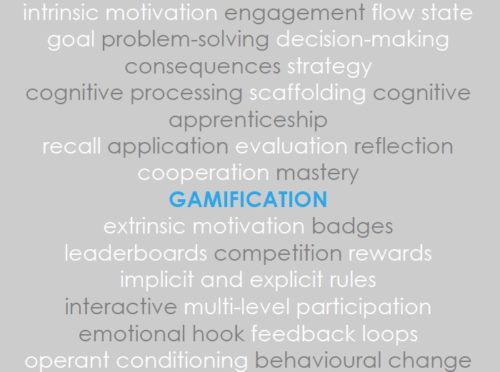The gamification of e-learning

The gamification of learning is about incorporating game design elements to enhance motivation and engagement in learning. In this post, I’ll reflect on a few aspects of gamification and consider how a particular type of course might benefit if delivered as an e-learning course with some elements of gamification.
Rewards
The term ‘gamification’ often brings to mind badges, leader boards and competitive elements. But this is misleading because it over-emphasises behaviourist principles of operant conditioning through positive and negative reinforcement.
There is, however, much more to the gamification of learning than just incorporating these reward elements, as suggested by the gamification word graphic. Indeed, many of these key words and concepts will be very familiar to educators and trainers.
A broader concept of gamification
Karl M. Kapp (2012) emphasises the emotional and cognitive aspects of gamification for engaging the learner in problem-solving and fostering higher order thinking. By deconstructing the elements of serious games, Kapp provides insights into features that work together to maintain motivation and interest, and makes a case for why educators should include them in course design. Key concepts and theories are explained in Kapp’s very readable book while his 2017 video Gamification in Interactive e-learning, highlights the relevance for developing workplace training courses and distinguishes between structural gamification and content gamification.
What kind of course content lends itself to gamification?
Gamification lends itself well to workplace training that reflects real experiences with direct relevance to the job the learner needs to do. It can also be useful for training fresh graduates to apply academic knowledge to workplace situations in scenarios abstracted from a real world context.
Example
An example that comes to mind is the experience of teaching an English for Specific Purposes course in which engineering students were involved in scenario-based learning and problem solving. Teams had to take into account geographical, political and technical factors in order to solve problems. The goal was for each team to develop a persuasive proposal and presentation in the hope of winning a project for their team’s fictitious engineering company.
This ESP course challenged students in a variety of ways and provided the opportunity to apply knowledge and develop new skills relevant to the workplace.
Drawbacks for face-to-face instruction
However, there were some issues that made implementation of this kind of course difficult in face-to-face mode. These included the following:
- the transfer of large amounts of information that the learners needed to take on board for building up the context so that they could imagine and assume their roles;
- the need to check individual students’ understanding of the input before moving onto application of knowledge and skills through team work;
- the inclusion of timely remediation if students had gaps in foundation knowledge or English skills that they needed to bring to the context;
- the difficulty of monitoring individual contributions in collaborative team work that needed to be carried out between lessons.
Improving course delivery through e-learning and gamification
On reflection, this kind of course could have been delivered more effectively as an e-learning course feeding into a blended learning programme. This could be achieved now by making use of currently available e-learning tools and some gamification elements to do the following:
- devise roles according to level of difficulty;
- allocate roles through pre-testing activities;
- enable students to choose avatars for carrying out roles;
- structure input and skills progression through progressive disclosure;
- provide levels to be unlocked on completion of problem-solving tasks;
- provide optional guidance (hints) for less proficient students;
- provide more quick check activities for knowledge and skills;
- deliver well-paced input more interactively by reducing the amount of text and reading involved;
- provide hands-on activities for learners to assimilate and apply knowledge;
- include pacing mechanisms such as timers and progress bars;
- provide instant feedback with additional input and guidance according to needs of different learners;
- monitor individual students’ contributions and coverage of course.
It is important to note that these improvements are only about how delivery of content can be improved. Content is still king and there is no substitute for quality content.
For a lot more investment in time and money, this kind of course lends itself to the total gamification experience such as the kind of scenario-based games that are currently being developed for some corporate training environments. But can the dry content of compliance and safety courses really have the power to motivate like slaying dragons and building empires can do?
Conclusion
There are many aspects of gamification worth exploring for course design, such as the ways in which timely feedback and input are delivered and the reward structures of games. Given that serious games are successful in challenging multiple levels of expertise to enable wider participation, this would also seem to be an aspect of learner differentiation worth exploring in e-learning course design.
But can gamification really work by incorporating selected elements into course design? Or, is the success of gamification really about the way in which all of the finely-tuned elements interact?
For further information about the gamification of learning see Kapp Karl M, (2012) The Gamification of Learning and Instruction: Game-Based Methods and Strategies for Training and Education. Published by Pfeiffer. A Wiley imprint.
